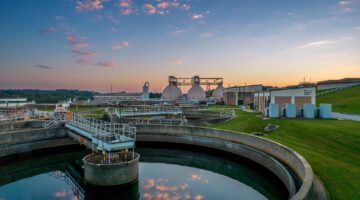Biological wastewater treatment is a process that utilizes bacteria and other microorganisms to remove contaminants from water. This method differs from chemical treatment, offering unique advantages and considerations. At Kiewit, we have the tools, systems and in-house expertise to not only implement these processes but also to educate and guide clients unfamiliar with this technology.
What is Biological Wastewater Treatment?
Biological wastewater treatment employs bacteria to remove carbonaceous material and nutrients from wastewater. This process transforms dissolved and particulate biodegradable organics into acceptable end products, captures suspended solids and removes nutrients like nitrogen and phosphorus from influent wastewater. Our in-house designs and data-driven models help optimize these systems for specific project requirements, making sure our clients get a tailored solution that works efficiently from day one.
What are the Steps for Biological Treatment Processes?
All biological systems follow the following three (3) steps to carry out treatment.
1. React: Bacteria converts pollutants into biomass and stable end products.
2. Separate/Settle: Bacteria form flocs that settle out of the water, allowing for the separation of clean effluent.
3. Remove/Return: Excess biomass is removed, and the remaining biomass is returned to the treatment zones to seed influent wastewater.
Carbonaceous Removal Process
Carbonaceous pollutants are absorbed and converted by organisms to grow and reproduce, known as Ordinary Heterotrophic Organisms (OHOs). Think of these bacteria as the “partiers”, eating food and reproducing quickly. With the use of oxygen, pollutants are converted to biomass and carbon dioxide.
Nitrification
Nitrification is the process of converting ammonia into nitrate through the action of two types of bacteria in the presence of oxygen:
- Ammonia-Oxidizing Bacteria (AOB): Oxidize ammonia to nitrite.
- Nitrite-Oxidizing Bacteria (NOB): Oxidize nitrite to nitrate.
Nitrifying bacteria (AOBs & NOBs) coexist with OHOs in the same basin, allowing simultaneous treatment reactions. These reactions mark the beginning of overall nitrogen removal and help prevent ammonia from entering the environment, where it can cause habitat damage.
Denitrification
Without oxygen, OHOs can use nitrates to “breathe,” a process known as denitrification, where nitrate is reduced to nitrogen gas. Denitrification occurs under anoxic conditions, characterized by low dissolved oxygen and elevated nitrate concentrations, often produced during nitrification. This biological method for nitrogen removal is commonly used in industry when chemical and stripping technologies are less economical.
Is Biological Treatment an Optimal Option for My Application?
Biological treatment is suitable for various applications, especially where organic contaminants are predominant. It is particularly effective for municipal wastewater treatment, where consistent influent quality and flow can be maintained. Industrial use cases of biological treatment can include, but is not limited to:
- Oil refining wastewater
- Refinery mash and wash water
- Food and meat production
- Enzyme and protein manufacturing wastewater
It is particularly useful in the industry for treatment of ammonia (NHx) as well, which is often challenging to remove without high chemical demand or a stripping tower.
What is an Example of a Successful Project?
City of Franklin Water Reclamation Expansion, Franklin, TN
The Franklin Water Reclamation Expansion Project demonstrates the application of advanced biological wastewater treatment to address critical water challenges. By integrating a thermal hydrolysis system, the project showcases how biological treatment can be optimized to produce high-quality biosolids, reduce landfill waste, and generate renewable energy. Throughout the project, biological sludge characteristics were quantified, allowing the plant to consistently outperform permit requirements, as it continues to do today.
How Can We Help You?
Addressing Water Scarcity and Regulatory Compliance
Our expansion projects demonstrate our commitment to providing solutions for water scarcity and regulatory compliance. By increasing the treatment capacity at Franklin to 16 million gallons per day, the facility can better manage water resources and meet growing demands. Additionally, the incorporation of advanced treatment technologies ensures that the discharged water meets stringent environmental standards, protecting water bodies and public health.
Key Takeaways and Conclusions
We lead the way in wastewater treatment solutions. Our expertise in designing and constructing complex wastewater treatment facilities positions us as leaders in the industry allowing us to:
- Optimize biological treatment processes: We implement innovative technologies like thermal hydrolysis to enhance biosolids management and energy recovery.
- Address water scarcity: By increasing treatment capacity and utilizing water-efficient designs, we help communities manage water resources more effectively.
- Meet regulatory requirements: With a proven track record of delivering projects that meet or exceed environmental standards, we prioritize compliance.
By partnering with us, clients can benefit from a comprehensive approach to wastewater treatment that addresses both environmental and operational challenges.

About the Author: Kyle Stern is a Lead Process Engineer specializing in the design and optimization of wastewater treatment (WWT) and renewable natural gas (RNG) systems. He focuses on delivering sustainable solutions for industrial and municipal projects.


